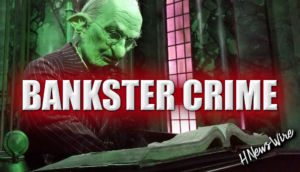
BanksterCrime:
These FDIC-Insured Banks Have Lost 69 to 40 Percent of their Market Value Year-to-Date
By Pam Martens and Russ Martens: August 13, 2024 ~
Here’s a look at three FDIC-insured banks that have lost 69 percent, 57 percent and 40 percent, respectively, of their share price year-to-date. The decline represents the change from their share price at the close on the last trading day of 2023 (Friday, December 29) and their close yesterday, (Monday, August 12, 2024).
New York Community Bancorp (Ticker NYCB): YTD Stock Performance, Down 69.33 Percent
New York Community Bancorp, Inc. is the parent company of Flagstar Bank, N.A., headquartered in Hicksville, Long Island, New York with 420 branch offices in 12 states. As of March 31, 2024, Flagstar had $112.8 billion of assets, ranking it the 28th largest bank in the United States according to a listing compiled by the Federal Reserve.
For more on what’s going on at NYCB, see our report: Steve Mnuchin, Trump’s Treasury Secretary/Foreclosure Kingpin, Joins with Hedge Fund Guys to Grab a Teetering, Federally-Insured Bank for $2 a Share.
Adding insult to injury, effective after the market closed on July 11 of this year, the stock did a 1-for-3 reverse stock split, meaning that for every three shares of stock that you previously owned, you now owned just one.
Patriot National Bancorp (Ticker PNBK): YTD Stock Performance, Down 57 Percent
Patriot National Bancorp is the parent of Patriot Bank, N.A. with headquarters in Stamford, Connecticut. As of March 31, it had just eight branch offices and a tiny $1 billion in assets. Its share price reflects ongoing losses being reported by the bank.
First Foundation (Ticker FFWM): YTD Stock Performance, Down 40 Percent
First Foundation is a small regional bank with 30 branches in five states. Like New York Community Bancorp, it has an over-concentration in loans on multifamily real estate. It reported $13.6 billion in assets as of March 31, 2024.
The share price took a particularly brutal beating in early July when it announced a $228 million equity infusion from a group led by Fortress, leading to serious dilution of existing shareholders. The deal came at a big cost, giving 49 percent ownership to the new investors, according to media reports.
~~~
These battered share prices are far from the worst episode to hit a federally-insured bank this year. On Friday, April 26, the FDIC announced the first federally-insured bank failure of 2024, the publicly-traded Republic First Bancorp (ticker FRBK) which did business as Republic Bank. (This failure is not to be confused with the much larger First Republic Bank that failed last year and was sold to JPMorgan Chase. (See our report: JPMorgan Chase, Officially the Riskiest Bank in the U.S., Is Allowed by Federal Regulators to Buy First Republic Bank.)
At the time of its failure, Republic First Bancorp was trading at 1-cent, down from 27-1/2 cents in September 2023 when we first reported that the stock had lost 96 percent of its market value in a year.
Federally-insured banks taking Mom and Pop deposits and then morphing into penny stocks is not really the stuff that builds confidence in the U.S. banking system.
Yes, it’s true that no depositor has lost a penny in a federally-insured bank since the creation of federal deposit insurance in 1933 if they remained under the federal insurance cap on deposits. Currently, that insurance cap is $250,000 per depositor, per bank.
But with federal regulators continuing to allow fintech to gain more footholds in banking, things are certain to keep blowing up.
After the media reported that the fraudster crypto exchange, FTX, was using Silvergate Bank for deposits, there was turmoil at Silvergate Bank last year, forcing it into eventual voluntary liquidation. (See Disgraced Silvergate Bank Hints It May Not Be Able to Cover All of Its Deposits; Fed Slaps It with a Cease and Desist Consent Order.)
A more recent embarrassment for U.S. banking regulators was the bankruptcy filing by Synapse Financial Technologies, a fintech startup that had financial backing from Andreessen Horowitz, the giant Menlo Park, California venture capital firm that has morphed into a major funder of the Super PAC, Fairshake, that is attempting to pack the U.S. Senate with crypto sycophants come the election in November. (See Crypto Just Got Exponentially More Dangerous: Meet Fairshake.)
Because Synapse was not a federally-insured bank but a middleman in facilitating deposit-taking for its clients at real banks, its bankruptcy collapse has left thousands of depositors unable to access over $100 million in deposits, which remain frozen or up in smoke.
How big is the potential scope of this dangerous marriage between fintech and banking? The Hill reported the following on July 25:
“While the numbers vary, fintech companies have been valued today at more than $1 trillion. There is another $2.5 trillion in cryptocurrencies represented by 10,000 different coins, as well as about $1.3 trillion in synthetic and derivative crypto securities being sold by Wall Street….”
Who benefits from this move fast and break things business model for federally-insured banking that is now gobbling up the U.S. financial system one disaster at a time? The venture capitalists who bring these untested fintechs to public markets as Initial Public Offerings become billionaires or super rich; the investment banks that underwrite these offerings get fat underwriting fees; and lawyers, like those at Sullivan & Cromwell, are able to bill more than $200 million when a fraudster fintech like FTX goes into bankruptcy, despite its legal work for FTX’s Sam Bankman-Fried when he was the golden boy of crypto.
Are we suggesting that fintech failures are a feature, not a bug, of this business model? The thought hadn’t crossed our mind until we wrote the above paragraph. But now that it’s out there – it’s worthy of deliberation since it’s certainly not depositors that are benefiting or the U.S. insured banking system as a whole.

Subscribe To BanksterCrime Today!
![]()




